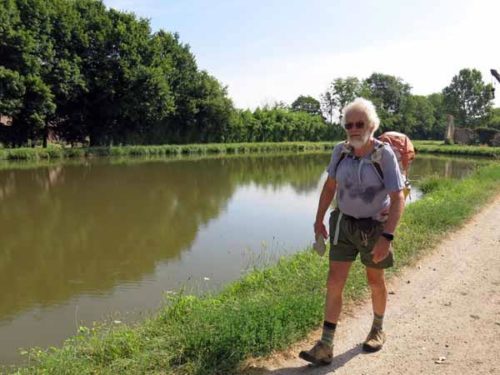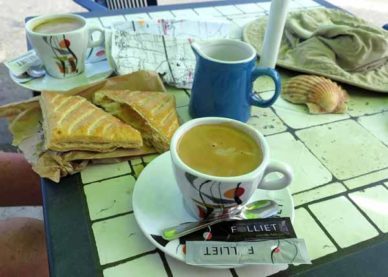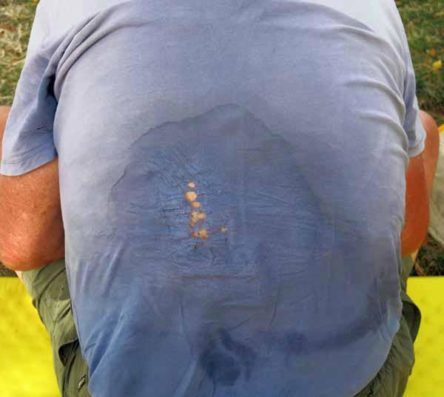
Sunday, 12 July 2015
Distance 29 km
Duration 6 hours 15 minutes
Ascent 10 m, descent 9 m
Map 134 of the
As we regained consciousness, the early sun streamed in through the flap of our tent and we heard the sounds of the farmyard – lowing cows, cackling hens, yapping dogs – on top of the usual twittering dawn chorus.
We intended to have breakfast at the bar in the village, which opened at 7:30 am. Before leaving the farm we washed the dishes from last night’s dinner and put them on the table with a thankyou note. The bottle of eau gazeuse was still half full, so we emptied it into our water bottle and it proved very refreshing later in the day.

It was exciting to be setting off on the last day of our walk, after more than a month on the track.
The weather was perfect and we had no worries about the route, half of which we had already done in 2010, nor the destination, where we had camped and dined twice before. It was like a holiday, and we realised how much stress we normally feel, arriving in a strange village with no guarantee of either a bed or a meal.
Walking back to Bannegon, we were pleasantly surprised to see the towers of the château peeping through a break in the trees. We had not noticed them on the way to the farm yesterday.
The village looked just as charming as before, and in the main square a market was setting up under the trees in front of the bar. A couple of bar tables were already occupied by rough-hewn stallholders.


We asked Sébastien about croissants and he said that the boulanger along the street only sold bread, not croissants. That was a bit sad, but we still had some of the baguette from last night, so we ordered our gran’crèmes and sat down.
Meanwhile his wife had slipped away around the corner, and came back triumphantly with a bag of croissants! We never found out how she did it.

After this excellent start, the real walking began. We meandered back to the war memorial and kept going along the D41 as far as a roadside cross, then to the right a short distance until we met the canal.
From there the towpath was a grassy wheel track shaded by the same handsome line of poplars as yesterday.
We passed a lock, then another one, and suddenly found ourselves at Fontblisse, the place that we had dreamed of returning to, where three branches of the Canal de Berry joined.
We had walked past this point in 2010 and always intended to come back along this third branch, so it was a moment of triumph.
From that point we were repeating our earlier walk and it was as peaceful a rural scene as could be imagined – truly la France Profonde.

The canal passed through fields of wheat and corn, patches of forest, pastures where white cows grazed, and stretches of the original shade trees beside the towpath. But perhaps not really the original trees – the canal was opened in the 1830s, so they would be getting pretty old by now.
There was a towpath on both sides and we were amazed to see a pair of walkers across the water, the first for over three weeks.
Actually it was not so surprising, because we were now on the Way of Vézelay, the second most popular pilgrim route in France.
Near Vernais we crossed to their side and found out that they were a young French couple who were halfway through a two-week section of the pilgrimage.
An hour and a half went by before we arrived at the village of Laugère, engraved into our memory because of the dreadful lunch we had eaten there on our last visit – pale, gluey blanquette de veau in an airless dining room.
This time we went to the same brasserie, but sat outside under a leafy canopy and only had coffee, which was delightful, so all was forgiven. With our coffee we finished the baguette from last night.
Back on the canal, we pressed on for three kilometres or so and came to Charenton-du-Cher. On the edge of the village someone had planted the canal bank with asters and buttercups, seemingly just for the joy of it.

This was where we had stayed with Mme Mativon in a grand old tumble-down house on the main square, but we noticed that the gîte sign was no longer on her gate – we imagined that she had died of old age by now.
We went into the boulangerie, because it was there and we had plenty of time, not because we were dying of hunger as we often are.
There was hardly anything left on the shelves, but we bought a galette feuillettée and carried it next door to the bar for our third mini-breakfast of the day. It was turning out a very agreeable final walk.
After Charenton we did not follow the GR654, preferring to stay beside the canal, so we were no longer repeating our previous walk. It was midday by this time, and getting very hot.
The towpath was as wide and bare as a highway and we hurried from one clump of trees to the next. I passed the time with the emperor Constantine and his troubles with the early Christians, who were starting off as they meant to continue by splitting into hostile sects, even before they were embraced by the Romans.
This last stage was longer than we expected, and we began to tire a little.
The canal was still beautiful but there was not much to catch our interest and the only living souls that we met were a few happy hens (if they have souls) scratching on the bank.
Nevertheless our entry into St-Amand-Montrond was much pleasanter than last time, when we had trudged through the industrial outskirts of the town.
As we reached the first houses, the banks of the canal became smooth lawn, the dusty grass of the towpath gave way to neat white gravel, and park benches appeared beside it.
Little hump-backed bridges crossed the water at intervals and we were horrified to find that our legs ached with the exertion of going over one of them. We had obviously spent too long walking on canals.
Coming to a road bridge, we looked down the street and saw the centre of town only a block away, but our immediate destination was the camping ground so we continued along the canal.
We began to recognise the little cottages beside us, and as the canal started to curve, we saw with joy the familiar flagpoles of the camping ground. It was hard to believe that after so many days of continuous walking, we had actually arrived at the end.
The woman in the office gave us a princely €1 discount for being pilgrims, bringing the cost down to €12.50, and we took ourselves off to the area reserved for small tents.
When we got back from the showers, the moment for lunch was well past and we lay about contentedly in the shade for the rest of the afternoon.
The only time that we got up was to take a boastful photograph our feet, which were completely unscathed after our 33-day walk. The same could not be said of Keith’s shirt, and it ended its life in a nearby rubbish bin.
At about
To get into town we went a different way from previous times, and in so doing found ourselves briefly on the official GR654 again, the Way of Vézelay. It turned off on a wheel track which contoured around the base of the fortress of Montrond, and the following morning we went that way to get to the railway station at Orval.
But this evening we kept going on the bitumen and popped out of the residential lanes into the main square just next to la Rotonde, a big Art Deco brasserie crowded with drinkers. We had a cleansing rosé there, but it was not the place to eat unless you liked chips and hamburgers, judging by what people had on their plates.
So when we finished our apéritifs we took a turn around the streets, looking at menus. There was surprisingly little choice for such a large town, and after surveying the other square across the road, we fell back on the place where we had eaten twice before, le Massilia.
Like many French pizzerias, it was also a complete restaurant, with a front room opening onto the street and another at the back, tucked away behind the pizza oven. We took a table in the front room, next to the open glass doors, where a lovely light breeze wafted in from the street.
There was a constant stream of people coming to collect their pizzas to take away, and the chef sweated profusely in front of the flaming red mouth of the oven. Several of the seated diners were also eating pizzas, but we had other ideas.
One of our rules, learned over many years of experience, is to only have pizzas when there is no other choice, the reason being that pizzas are usually the last thing to disappear from the dining possibilities of a town.

We started with a big green salad which we shared, mopping up the last of the dressing with bread.
The main course in Keith’s case was a rich lasagne, and in mine steak with green peppercorn sauce and gratin dauphinois, my favourite.
We were conscious that this was our farewell to French dining for the year, and it had all the attributes – the warm evening, the convivial atmosphere, the wine, the endless fresh bread and the delicious food.
Finishing in style, we shared a Café Liégeois, with a gaudy banner planted on top like the flag of some conquering mountaineer. Although we had hardly been able to make the ascent of a hump-backed bridge earlier in the day, we felt we had something in common with conquering mountaineers.
I made an effort to eat some of this festive dessert, but by that time I was too full to be much help.
We strolled back to our tent in a very happy frame of mind, pleased to be going home, but equally pleased with what we had done.
Leaving St-Amand-Montrond
Early next morning we took the back route, around the fortress of Montrond, to the railway station at Orval, where we threw away the last crumpled, stained page of the two hundred maps that we had used on the walk.
The train left at 7:28 and we had a longish wait at Vierzon for the connecting train to Paris, so we took the chance to spend all our remaining euros on French chocolate. Arriving at Paris Austerlitz about 2:30 pm, we had enough time to walk from there to the Gard du Nord, where we caught the RER to Charles de Gaulle airport.
That evening we were in the air on our way home. We must have been the only passengers who found the tourist-class seats comfortable, having sat and slept on the ground for a month.
Previous day: Dun-sur-Auron to Bannegon













